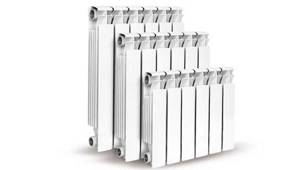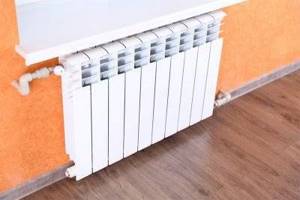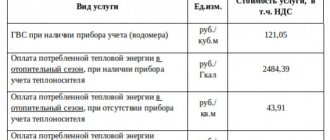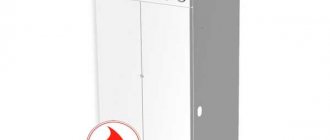Disadvantages of bimetal radiators
Like other types of radiators, bimetallic batteries have their disadvantages. Among the most significant we note the following:
- price is the main disadvantage of bimetal products. The costs of purchasing them are very high in comparison with cast iron heating appliances. But they have a more pleasant appearance. These heating devices can be easily integrated into a modern interior, and in terms of the duration of the operating period they are ahead of all other types of heating products;
- Another disadvantage of these products is the poor corrosion resistance of the core of these radiators, which is made of steel. This happens under the influence of water and air. Rust on bimetallic radiators can also appear under the influence of antifreeze, which is used as a coolant in autonomous heating systems by owners of private houses. If the choice was made in favor of such a coolant, then the best solution is aluminum batteries.
Basic data for calculating heating radiators
First of all, you need to determine the basic parameters on which the calculation will be based. These include:
- room dimensions;
- preferred type and material of radiator;
- thermal power - the entire battery for monolithic products or individual sections for prefabricated options;
- permissible number of sections - in each case it is limited by the design features of the battery.
Keep in mind that depending on the material of manufacture, the performance characteristics of radiators will vary significantly. Therefore, the calculation should be done initially for a specific metal and type of structure. To make it easier for you to navigate these subtleties, we have collected the average performance indicators of different types of batteries in a visual table.
| Radiator type | Thermal power of 1 section, W | Coolant operating pressure, atm | Permissible coolant temperature, degrees. | Heat transfer coefficient due to radiation, % |
| Cast iron | 100 | 9 | 130 | 70 |
| Steel | 120 | 8-12 | 120 | 50 |
| Bimetallic | 150 | 16-35 | 130 | 50 |
| Aluminum | 200 | 6-16 | 110 | 50 |
Keep in mind that these are average values; for a particular model they may differ either less or more. In addition, remember that not all types of radiators are suitable for use in individual heating systems. We have already written about how to choose batteries for a private home.
Determining the number of aluminum battery sections
It is not easy to recalculate the parameters of a heating device for specific conditions. The thermal power formula and calculation algorithm used by design engineers are too complex for ordinary homeowners who are ignorant of heating engineering.
We suggest calculating the number of sections of heating radiators using a more accessible method that gives a minimum error:
- Collect the initial data listed in the first section of this publication - find out the amount of heat required for heating, the temperature of the air and coolant.
- Calculate the actual temperature difference DT using the above formula.
- When choosing a specific type of battery, open the technical data sheet and find the heat transfer rate of 1 section at DT = 70 degrees.
- Below is a table of ready-made conversion factors for the heating power of radiator sections. Find the indicator corresponding to the real DT and multiply it by the value of the rated heat transfer - get the power of 1 fin under your operating conditions.

Knowing the real heat flow, it is not difficult to find out the number of battery fins required to heat the room. Divide the required amount of heat by the output of 1 section. For clarity, here is an example calculation:
- Let's take a corner room with two translucent structures (windows) with an area of 15.75 m², ceiling height - 280 cm (shown in a fragment of the drawing). Specific heat consumption for heating is 130 W/m², the total requirement will be 130 x 15.75 = 2048 W.
- We found out the magnitude of the thermal pressure in the previous section, DT = 43 °C.
- We select low aluminum radiators GLOBAL VOX 350 (center distance - 350 mm). According to the product documentation, the heat output of 1 fin is 145 W (DT = 70 °C).
- We find in the table the coefficient corresponding to DT = 43 °C, K = 0.53.
- We multiply the nameplate power by the coefficient and find the real output of 1 section: 0.53 x 145 = 76.85 W.
- We calculate the number of aluminum fins per room: 2048 / 76.85 ≈ 26.65, round up and get 27 pieces.
All that remains is to distribute the sections throughout the room. If the window sizes are the same, we divide 28 in half and place a radiator with 14 fins under each opening. Otherwise, the number of battery sections is selected in proportion to the width of the windows (approximately possible). The heat transfer of bimetallic and cast iron radiators is recalculated in a similar way.

Battery placement diagram - it is better to place devices under windows or near a cold outer wall
Many well-known companies, including GLOBAL, indicate in the documentation the heat transfer of their devices for different temperature conditions (DT = 60 °C, DT = 50 °C), an example is shown in the table. If your real ΔT = 50 degrees, feel free to use the specified characteristics without any recalculation.

Basic calculation options
Now let’s figure out how to select the number of heating radiator sections for a particular room; there are many methods; we will consider only those that are easiest to implement and give a relatively accurate result.
Simplified technique
If you use this option, you need to be guided by the following principle: for a room in central Russia, located in a multi-story building, which has one external wall and one window, a thermal power of 100 W per m2 is required. In this case, the ceiling height should not exceed 2.8 meters.
A simple formula will allow you to easily carry out calculations
Let's look at a specific example, you only need to know how many m2 are in the room:
- Let's say we have a room with an area of 15 square meters with one window and one external wall, its ceiling height is 2.5 meters;
- For heating, cast iron radiators with a center distance of 50 mm will be used;
- Everything is very simple here: the number of radiator sections per 1 m2 is 1, that is, 15 sections are needed for 15 meters. Of course, if the coolant temperature in your system is 90 degrees, then the heat transfer from the batteries will be approximately 150 Watts, and 10 fins will be enough for you, but in practice such cases almost never happen; on average, the liquid heats up to only 70 degrees;

A cast iron radiator with 15 sections will allow you not to be afraid of even the most severe frosts
- If you have a corner room or a ceiling height of 3 meters or higher, then the result obtained must be multiplied by 1.2-1.3, depending on the quality of wall insulation and the type of window blocks used.
Important! In addition to all the above factors, the type of installation of radiators and the type of their connection also matters, so take these nuances into account and, if necessary, make adjustments to the final result.

This is how the connection options are arranged in order of preference, if the first two provide excellent efficiency, then in the third about 10% of the power is lost, and in the fourth even 15-20%
Using online calculators
The instructions for carrying out this type of calculation are also very simple; the most important thing is to find a quality resource with a good program that takes into account the maximum number of additional factors. This is the only way to guarantee that you will accurately determine how many square meters a particular radiator option will be enough for.

There are separate versions of programs for private houses
As for the calculations, they are simple:
- Enter all the requested data into the program fields , the more reliable and accurate they are, the better, because this affects the accuracy of the calculations;
- If there are no criteria in the calculator, then you simply multiply the result by a certain index (for example, the location of radiators is not always taken into account, but when determining how many radiator sections are needed, this factor cannot be overlooked).

As you can see, a lot depends on the installation option
Calculation based on volume
A very popular option due to the fact that it allows you to calculate the number of sections very accurately, some argue that the obtained value is overestimated, but it is better to install a radiator in 12 sections instead of the required 10 and use a regulator to maintain the desired temperature than install a radiator in 8 sections and at In extreme frosts, use additional heaters.
As for this technique, it is simple: you need to measure the actual length, width and height of the room and multiply the values together, the resulting result will be the volume in cubic meters. This value is multiplied by 41 - this is exactly how many watts are needed per cubic meter of air; with high-quality insulation and the use of energy-saving double-glazed windows, 34 watts per cubic meter is enough.
When making calculations, take into account the size of the heating radiator section; sometimes you have to install radiators lower than planned due to the characteristics of the room.

The higher the sections used, the greater their heat transfer
Some developers ask what to do if the calculation was made incorrectly and additional sections of heating radiators need to be installed? There can be two solutions - either add elements to an already installed structure (and its width should not be more than 16 ribs), or install a separate battery, it all depends on which option is easier to implement and better suits a particular room.
How to calculate the number of radiator sections
There is a simplified way to do this quickly. To do this, we will need the standard power required to heat one square meter of room. Let's give three options.
- If the ceilings in the room are of normal height (from 2.5 to 2.7 meters), there is one wall facing outwards, and one window. Standard power is 100 watts.
- If the ceilings are the same, there are two walls outwards, and one window. Standard power is 120 watts.
- If the ceilings are the same height, there are two walls outward, and there are two windows. Standard power is 130 watts.
Now let’s multiply two values – the standard power for our option and the area of the room. If you have higher ceilings or a larger window (for example, if it has a bay window), we will additionally multiply by a correction factor of 1.1. As a result, we get the radiator power (total).
The radiator's passport indicates the thermal power for one section. The resulting total power must be divided by it. We round fractional numbers upward.
Heat transfer from heating batteries: what is it, its calculation according to the product data sheet
The amount of heat that is transferred per unit time to a certain volume per unit time is the heat transfer of the heating battery. Heat output is sometimes called thermal power because it is measured in watts.

Sometimes heat transfer is called heat flow power, and therefore you can find the unit of measurement of heat transfer cal/hour in the product passport. There is a relationship between Watts and calories per hour: 1 W = 859.85 cal/hour.
The manufacturer indicates the nominal heat transfer parameter in the radiator passport. Based on this parameter, you can calculate the required number of elements for each individual room or room. If the passport indicates the power of one section is 150 W, then a section of 7 elements will produce more than 1 kW of heat.
Calculation of real heat transfer in kW
To do this, you need to decide on the number of external walls and windows. With one external wall and one window for every 10 m² of room area, 1 kW of heat will be required.
If there are two external walls, then for every 10 m² 1.3 kW of thermal energy will be required.
More precisely, you can calculate the required power using the formula Sxhx41:
- S is the area of the room;
- h is the height of the room;
- 41 is an indicator of the minimum power per 1 cubic meter of room volume.
The resulting thermal power will be the required full power of the heating battery. Now all that remains is to divide by the power of one radiator and determine their number.
Formulas for accurate calculations

KT=1000 W/m²*P*K1*K2*K4…*K7.
The CT indicator is the amount of heat for an individual room.
P - Total area of the room.
K1 is the coefficient for taking into account window openings. If there is a double window, then K1 = 1.27.
- Double glazing - 1.0,
- Triple glazing - 0.85.
K2 - coefficient of thermal insulation of walls:
- Thermal insulation is very low - 1.27;
- Laying walls with 2 bricks and insulation - 1.0;
- High-quality thermal insulation - 0.85.
K3 - ratio of window area to floor area in the room:
- 50% — 1,2;
- 40% — 1,1;
- 30% — 1,0;
- 20% — 0,9;
- 10% — 0,8.
K4 - average air temperature in the room during the coldest period:

- 35 °C - 1.5;
- 25 °C - 1.3;
- 20 °C - 1.1;
- 15 °C - 0.9;
- 10 °C - 0.7.
K5 - accounting for external walls:
- 1 wall - 1.1;
- 2 walls - 1.2;
- 3 walls - 1.3;
- 4 walls - 1.4.
K6 - type of room above the room:
- Cold attic (uninsulated) - 1.0;
- Attic with heating - 0.9;
- Heated room - 0.8.
K7 - taking into account ceiling heights:
- 2.5 m - 1.0;
- 3.0 m - 1.05;
- 3.5 m - 1.1;
- 4.0 m - 1.15;
- 4.5 m - 1.2.
This calculation takes into account the maximum number of features of the room for heating.
Attention! The result must be divided by the heat transfer of one radiator and the result rounded up
Calculation by area
The previous calculation method is an excellent solution for rooms with a height of more than 2.7 m. In rooms with lower ceilings (up to 2.6 m), you can use another method, taking the area as a basis.
In this case, calculating the total amount of thermal energy, the need per square meter. m is taken equal to 100 W. There is no need to make any adjustments to it for now.
Formulas for calculating the number of sections by room area, with an example
- At the first stage, the total area of the room is determined: [length]* [width]
(5x4=20 sq. m.) - The next step is to determine the heat required to heat the entire room: [area]* [requirement per sq. m.]
(100x20=2000 W) - In the passport attached to the heating radiator, you need to find out the power of one section - the average for modern models is 170 W
- To determine the required number of sections, use the formula: [total heat demand]/[power of one section]
(2000/170=11.7) - We introduce correction factors (discussed below)
- It is recommended to round up – we get 12 sections
Design of bimetallic heaters
The body of these radiators is figured-ribbed, made of aluminum alloy, which is distinguished by excellent heat transfer. Under the housing there is a heating circuit made of pipes (copper or steel).
This “filling” helps the battery adequately withstand the attack of chemical and mechanical impurities present in hot water for heating.
The steel from which the core tubes are made is very strong. Therefore, the radiator will withstand even under high pressure. This can be 20, or even 40 atmospheres (some models up to 100 atmospheres). And the temperature of the coolant can rise to 110 or 130 degrees. If you need more specific numbers, you need to look at the passport of a specific radiator. Aluminum not only increases heat transfer, but also significantly makes the device lighter. In addition, the complex shaped housing has a very attractive design, giving the radiators an excellent appearance.
According to their characteristics, these radiators are quite suitable both for apartments in buildings of various heights, and for individual cottages with autonomous heating systems.
But don’t rush to the store right away - first we’ll tell you how to intelligently approach the issue of choosing them. Date: September 25, 2021










